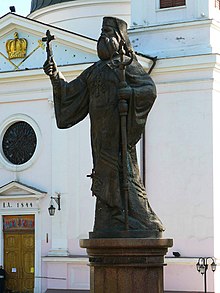Eugen Hackmann
Eugen Hakmann ; also: Hackmann , Ukrainian: Євген Гакман (Jevhen Hakman) , Romanian: Eugenie Hacman ; (Born March 16, 1793 in Wasloutz (Vaslăuți), Bukowina ; † April 12, 1873 in Vienna , buried in Czernowitz (Cernăuți) ) was a high Orthodox clerical dignitary ( Archbishop of Czernowitz, Metropolitan of Bukovina and Dalmatia ) and Austrian politician, first governor of the Duchy of Bukovina and member of the manor house of the Austrian Imperial Council .
ancestry
The family originally came from the Hotin area . She inherited the name from an ancestor who had been Hatman . There was a sound shift in the naming. The patronymic was probably first used in Bukovina as "Hakmann" or "Hacman". The future archbishop came from a meanwhile impoverished farming family from a village near Zastavna in the Chernivtsi district.
biography
An uncle made it possible for the baptized Iftimie to attend a higher ecclesiastical institution in the state capital. The then Bishop Daniel Wlachowicz (Vlahović, Vlahovici) then paid him to stay in the kk Konvikt and study theology at the Roman Catholic (!) Theological faculty of the University of Vienna from 1819 to 1823 . In 1823 Iftimie took monastic vows, taking the name Eugenie, and was ordained a priest. He worked at the Greek Orthodox Trivial School in Chernivtsi as archimandrite and priest monk in the Dragomirna monastery .
In 1827 he was promoted to professor for Bible studies at the newly established theological school there, where he vehemently and finally successfully campaigned for the introduction of the Romanian language of instruction.
On May 8, 1835, he was ordained bishop of Chernivtsi and Bukovina. During his tenure, he campaigned for the development of elementary and denominational schools and also had many founded, with Romanian as the language of instruction. He also constituted the high school of Suceava (Suczawa) in 1860 . In the church administration, however, he favored German as the official language. He also supported the construction of new churches, and the Archbishop's Palace (completed in 1882) and the Greek Orthodox Cathedral were built during the period of his activity (1844–1864).
Hakman developed into one of the most active champions of the liberation of the beech country from Galician dependence. As early as 1848 he had co-signed the petition for the separation of Bukovina from Galicia . After the February constitution came into force on February 26, 1861, the Bucovina state parliament elected him as the first governor of the duchy, an office he held until his resignation in early December 1862. In the same year he became a member of the manor for life.
A few months before his death on January 23, 1873, he was elevated to the rank of archbishop and metropolitan for the newly created archbishopric of Bukovina and Dalmatia by the decree of Emperor Franz Joseph I.
At his funeral, the kuk Interior Minister Josef Anton Lasser Freiherr von Zollheim , the Minister for Education and Culture Karl Ritter von Stremayr and Trade Minister Anton Freiherr von Banhans were among the many mourners . His body was transferred to Chernivtsi and buried in the cathedral.
Hakmann was the bearer of the Commander's Cross of the Franz Joseph Order . The Bischof-Hakman-Gasse in Chernivtsi was named after him. He was an honorary citizen of the cities of Chernivtsi and Sereth (Siret) .
On the occasion of the 135th anniversary of his death, the Ukrainian Orthodox Church (Moscow Patriarchate) had a massive, larger-than-life bronze monument erected in front of the main church in Bukovin, and the Ukrainian Orthodox Church (Kiev Patriarchate) had a bronze plaque in sight.
literature
- Mihai-Ştefan Ceauşu: The historical development of the Romanian political parties in Bukovina and their most important representatives in the Reichsrat and Landtag (1861-1914) Institute for History "AD Xenopol" of the Romanian Academy, Bucharest 2011
- Andreas Kappeler: "The Ukraine - Processes of Nation Building", Böhlau Verlag, Cologne 2011,
- Emil Satco: "Enciclopedia Bucovinei", Princeps Edit publishing house, Iași 2004
- IG Sbiera, Enciclopedia Română, (1899), Vol. I.
- (Funeral). In: Wiener Zeitung , April 16, 1873, p. 4 (online at ANNO ).
- Eugen Hackmann. In: Austrian Biographical Lexicon 1815–1950 (ÖBL). Volume 2, Verlag der Österreichischen Akademie der Wissenschaften, Vienna 1959, p. 156.
Individual evidence
- ↑ Emil Satco "Enciclopedia Bucovinei", publishing Princeps Edit, Iasi 2004, p 468
- ↑ Klagenfurter Zeitung No. 294, from Tuesday, December 23, 1862, p. 1175
- ^ Wiener Zeitung of April 16, 1873
- ↑ Mihai-Ştefan Ceauşu: The historical development of the Romanian political parties in Bukovina and their most important representatives in the Reichsrat and Landtag (1861-1914) Institute for History "AD Xenopol" of the Romanian Academy, Bucharest 2011, p. 99 f
- ↑ Kurt Scharr: " The Bukowina Landscape: The Becoming of a Region on the Periphery 1774-1918", Böhlau Verlag, Vienna 2010, p. 175
- ^ Neue Freie Presse of April 16, 1873, p. 5
- ^ Andreas Kappeler : "The Ukraine - Processes of Nation-Building", Böhlau Verlag, Cologne 2011, p. 264 f
| predecessor | Office | successor |
|---|---|---|
| - |
Governor of the Duchy of Bukovina 1861–1862 |
Eudoxius Freiherr von Hormuzaki |
| personal data | |
|---|---|
| SURNAME | Hackmann, Eugene |
| ALTERNATIVE NAMES | Hackmann, Eugen; Hakmann, Eugen; Hacman, Eugenie (Romanian); Hackman, Eugene |
| BRIEF DESCRIPTION | Romanian metropolitan and Austrian politician |
| DATE OF BIRTH | March 16, 1793 |
| PLACE OF BIRTH | Wasloutz |
| DATE OF DEATH | April 12, 1873 |
| Place of death | Vienna |



